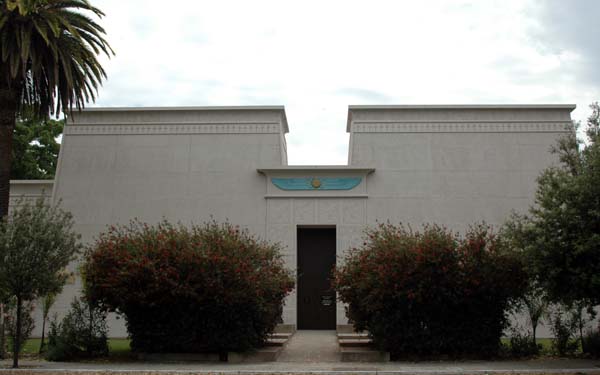
- Rosicrucian Museum
- From the beginning of the work of the Rosicrucian
Order, AMORC in the 20th century, Egypt loomed large. From 1915 to 1927, at
the Order's early headquarters in New York City, San Francisco and Tampa Dr.
Lewis, the first Imperator of AMORC began to collect artefacts from "the
Orient," through the generosity of members.
-
- In 1921, Dr. Lewis urged Order members to support the
excavations of the Egypt Explorations Society of Boston in Tell el Amarna,
the city of the King Akhenaten and as a result garnered a significant funds
for the project.
-
- In gratitude, the Egypt Explorations Society donated
several artefacts from their finds. After the Order's headquarters settled
in its present San Jose location, Dr. Lewis conceived of a public
collection, "The Rosicrucian Egyptian Oriental Museum" in 1928. He had glass
cases for the artefacts built in a lounge area of the second floor of the
Administration building.
-
- A grand tour of Egypt followed in 1929, and this
enthusiasm generated many more donations of artefacts and funds for the
Museum. By 1932 the collection had outgrown its second floor home, and
additional construction was added as an annex to the Administration
Building.
-
- Although the many artefacts in the collection
themselves were actual ancient antiquities, as a teaching institution,
educational replicas were also needed. In 1935, the carefully detailed Rock
Tomb replica, modelled on several originals in the Beni Hasan desert was
unveiled. The second teaching replica was the model of the Djoser Step
Pyramid complex, lovingly crafted by the museum staff and volunteers.
-
- The familiar Byzantine design and Moorish arches of
the Museum greeted visitors for over thirty years. As the collection grew
and deepened, however, it became obvious to Ralph M. Lewis, AMORC's second
Imperator, that a fully modern museum facility was needed for the more than
2,000 artefacts.
-
- In November 1966 the new museum building opened, the
largest display of Egyptian artefacts in the Western U.S., the only such
Museum on the planet designed in the Egyptian style, and situated in an
Egyptian revival park.
-
- In 1999, the Museum mounted its first travelling
exhibition, Women of the Nile, which included a full series of lectures and
workshops. The exhibit travelled during 2000 and early 2001 in the U.S. and
Canada, and an exhibit catalogue was published to accompany the event.
-
- From October 2000 through March 2002, the Museum's
stone figure of Cleopatra VII travelled as part of an exhibit in Rome,
London and Chicago. The 21st century looks promising with new exhibits,
tours and workshops, continuing research and scholarship, and a perennial
commitment to education and service.
| |
